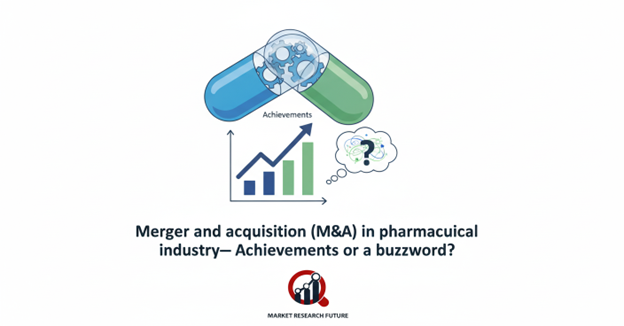
Mergers and Acquisitions Pharmaceutical Market Overview
The global pharmaceutical industry has undergone significant consolidation over the past two decades, with mergers and acquisitions (M&A) emerging as a key strategic tool for growth, diversification, and survival in an increasingly competitive and innovation-driven landscape. The phrase “United we stand, divided we fall” aptly reflects the mindset of many pharmaceutical giants that have turned to M&A to strengthen market position, offset patent losses, and expand into new therapeutic areas and geographies.
Historically, M&A in the pharmaceutical sector has been driven by the need to maintain revenue streams amid patent expirations, rising R&D costs, and regulatory complexities. While consolidation has helped large players gain economies of scale, expand product portfolios, and enter new markets, it has also raised questions about innovation, efficiency, and long-term value creation. The debate remains: Are these mergers truly transformative achievements, or simply short-term fixes masking deeper structural issues?
Market Growth Influencers
The motivations behind pharmaceutical M&A are multifaceted, spanning financial, strategic, and operational drivers. Some of the key growth influencers include:
1. Economies of Scale and Financial Leverage
Many major acquisitions are motivated by the need to leverage large cash reserves and achieve cost synergies. Post-recession, low interest rates further incentivized acquisitions as companies sought to replace lost revenues from expiring patents. For instance, M&A deals allowed firms to consolidate R&D pipelines and reduce duplication in manufacturing and distribution.
2. Product Diversification and Market Expansion
Uncertainties in drug development have led pharmaceutical firms to acquire companies with complementary portfolios or emerging therapeutic expertise.
- In 2015, AbbVie acquired Pharmacyclics for 21 USD Billion, expanding into cancer and immune-disease therapies.
- Valeant’s 10.1 USD Billion acquisition of Salix Pharmaceuticals and Novartis’s 39.3 USD Billion purchase of Alcon illustrate diversification into high-growth segments like medical devices and specialty therapeutics.
3. Patent Losses and Revenue Preservation
The top 10 pharmaceutical companies have seen market share declines—from nearly 50% in 2007 to 35% by 2015—largely due to patent cliffs. M&A became a strategic response to replenish pipelines and sustain market equity. For example, Pfizer’s acquisitions of Warner–Lambert (2000) and Pharmacia (2002) secured blockbuster drugs like Lipitor and Celebrex.
4. Market Development and Geographic Expansion
Firms are increasingly targeting emerging markets to diversify revenue streams. A notable case is Abbott Laboratories’ 3.72 USD Billion acquisition of Piramal Healthcare’s domestic formulation business in India, strengthening its foothold in high-growth emerging economies.
5. Core Specialization and Operational Efficiency
In an effort to streamline operations, companies are divesting non-core assets. For example, Allergan sold its generic drug division to Teva for 40.5 USD Billion, allowing both companies to sharpen focus on their respective strengths—innovative therapies and generics.
Current Weaknesses and Challenges
While M&A delivers short-term financial and strategic gains, several structural weaknesses and risks have emerged:
- Overvaluation & Goodwill Pressure: Acquisitions at inflated valuations strain balance sheets and limit future ROI.
- Innovation Slowdown: Consolidation may stifle creativity, as large organizations often struggle with agility and risk-taking.
- Operational Complexities: Integrating diverse systems, cultures, and portfolios can lead to inefficiencies.
- Unsustainable Revenue Models: Overreliance on inorganic growth may overlook organic R&D innovation.
- Risk of Failures: The short-lived Daiichi–Ranbaxy partnership underscores potential pitfalls in strategic mismatches.
Strategic Insights: Is M&A a Sustainable Growth Strategy?
While M&A provides immediate access to new markets, molecules, and technologies, its sustainability as a long-term growth strategy remains debatable. True value creation lies not merely in revenue expansion but in operational efficiency, innovation nurturing, and cost optimization.
Key Considerations for Sustainable M&A:
- Value Creation over Revenue Maximization: Prioritize synergies that enhance innovation and efficiency.
- Lean Operations: Adopt Six Sigma and lean manufacturing principles to control operating costs.
- Digital Transformation: Integrate analytics, AI, and automation in supply chain and marketing operations.
- Strategic Divestitures: Shed low-value assets to refocus on high-growth therapeutic areas.
- Collaborative Models: Partnerships and licensing agreements can complement acquisitions with lower risk.
Future Outlook
The future of pharmaceutical M&A will be shaped by innovation-driven deals, biotech partnerships, and cross-sector acquisitions in areas such as digital health, AI in drug discovery, and personalized medicine. Companies will increasingly adopt a balanced strategy, combining targeted acquisitions with organic R&D investments to maintain competitiveness.
Investors and stakeholders will favor firms that demonstrate sustainable growth, operational efficiency, and value-driven acquisitions over aggressive expansion. The focus will shift from “bigger is better” to “smarter and leaner is stronger.”
Conclusion
Mergers and acquisitions have undeniably transformed the pharmaceutical landscape—helping companies offset patent losses, expand portfolios, and enter new markets. Yet, the success of M&A depends on strategic alignment, integration efficiency, and long-term value creation rather than short-term revenue gains.
To truly thrive in a dynamic and innovation-driven industry, pharmaceutical companies must view M&A not as a buzzword or quick fix, but as part of a comprehensive strategy centered on innovation, operational excellence, and sustainable growth.